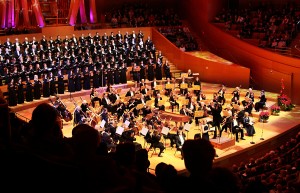Los Angeles Master Chorale performs Orff classic
As part of its 50th anniversary season, the Los Angeles Master Chorale presented Carl Orff’s Carmina Burana on Saturday and Sunday. The Master Chorale has close ties with Orff’s work. Since its inception, each of the four choral directors has led the L.A. Master Chorale in Orff’s piece. This performance marked the chorale’s 17th rendition of the piece and the second under director Grant Gershon. Over the years, each of the chorale’s four music directors have conducted the choral standard with a slightly different variation. The chorale’s repeated performances reflect the cyclical nature of the piece itself and its staying power. Since its composition, the grand and ominous-sounding “O Fortuna,” which bookends the piece, has appeared in countless films and TV shows.

Good fortune · The Los Angeles Master Chorale’s performance of Carl Orff’s “O Fortuna” has a special symbolic significance: The cyclically themed work marked the beginning of the 2013/2014 choral season. – Photo courtesy of Los Angeles Master Chorale
Carl Orff composed Carmina Burana in 1937, taking the text from a series of medieval poems by the same name from a monastery in Benediktbeuren, Bavaria. The title is derived from Latin and means “poems from Beuren.” Though these poems were found in a monastery, they stray from typical religious themes. Penned by rebellious seminary students and vagabonds, these “goliardic” poems address human flaws, sexuality and the nature of desire. The work is divided into three sections: lyrical “Spring,” party-like “In the Tavern” and sentimental “The Court of Love.” Akin to modern day satires and lighthearted social critiques, these poems evoke a rebellious and witty spirit.
When the piece debuted in Frankfurt’s Opera House in 1937, Orff included elaborate scenery and costumes to complement the modernist sounds of the piece. At the time of its debut, this piece provided a refreshing contrast to the dense orchestrations other composers employed.
As Alan Chapman, host of KUSC, noted: “[Carmina Burana] sounds like nothing else ever written.”
Most notably, Orff uses a series of simple repetitive motifs in the orchestral accompaniment to the third section of the piece, “The Court of Love.” These rhythmic and harmonic melodies seem to be a precursor to the minimalist movement. Yet Orff’s work cannot be easily categorized into a single musical style; it explores a variety of vocal techniques. The concert’s three soloists played on the theatrical aspects of the work, adding to the piece as a whole. Though the Master Chorale did not stage Carmina Burana like an opera, the 115-person Master Chorale and the Los Angeles Children’s Chorus gave a magical and fairytale-like rendition of Orff’s piece, complete with stunning solos and lush orchestral accompaniment.
The spirited performance and lighthearted nature of Carmina Burana contrasts with the concert’s opening piece, Verdi’s Te Deum. In 2006, Gershon paired Carmina Burana with Cliff Eidelman’s Wedding in the Night Garden. Previous LAMC conductors have paired it with Mozart’s Mass in C Minor and Morten Lauridsen’s Les Chansons des Roses. Former director John Currie juxtaposed Carmina Burana with Antonín Dvorák’s Te Deum and Aaron Copland’s “Four Dance Episodes” from Rodeo. Each composer brought his own flavor to Orff’s piece and the LAMC website allows listeners the chance to compare various renditions.
In the “Listen Up!” pre-concert talk, Gershon described Verdi’s Te Deum as one of his “desert island pieces,” or pieces he would take with him to a deserted island. He added that the piece is especially relevant because this year marks the 200th anniversary of Verdi’s birth. Verdi’s dramatic Te Deum recalls a more traditional, though no less monumental, choral piece. Composed when Verdi was 82, this piece draws from the Latin story of Saint Ambrose’s baptism by Saint Augustine and is commonly referred to as the “Ambrosian hymn.” Verdi builds drama and grandeur by giving the tenors and basses a distinct and thematic melody. Te Deum uses a double choir to create a robust and overwhelming sound. The piece begins with an a cappella opening and increases in scale. Though the work is considered Verdi’s most musically unified piece, each song in Te Deum involves vivid change of character. Aside from featuring robust chant-like lines in the bass and tenor sections, this piece also takes on a lighter, more haunting quality with the soprano and alto parts. The orchestra adds richly contrasting countermelodies that provide jewel-like color and depth. The piece ends with a call and response between the orchestra and a single soprano voice.
Te Deum weaves a rich, traditional tapestry of sound while Orff’s Carmina Burana paints an aural fairy tale, more akin to the stories of The Brothers Grimm. The pieces complement each other and showcase the skill and versatility of the choirs and orchestra. Though Carmina Burana has become an LAMC standard, the Master Chorale renews Orff’s works with each performance. Like the shifting light shining through a stained glass window, each experience is singular and captivating.
